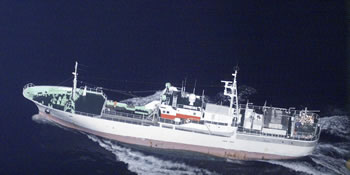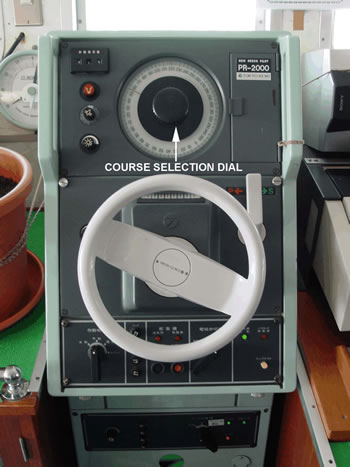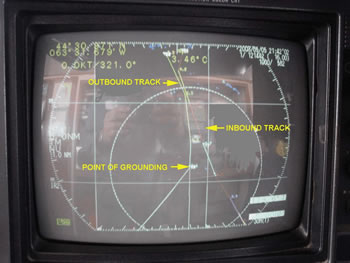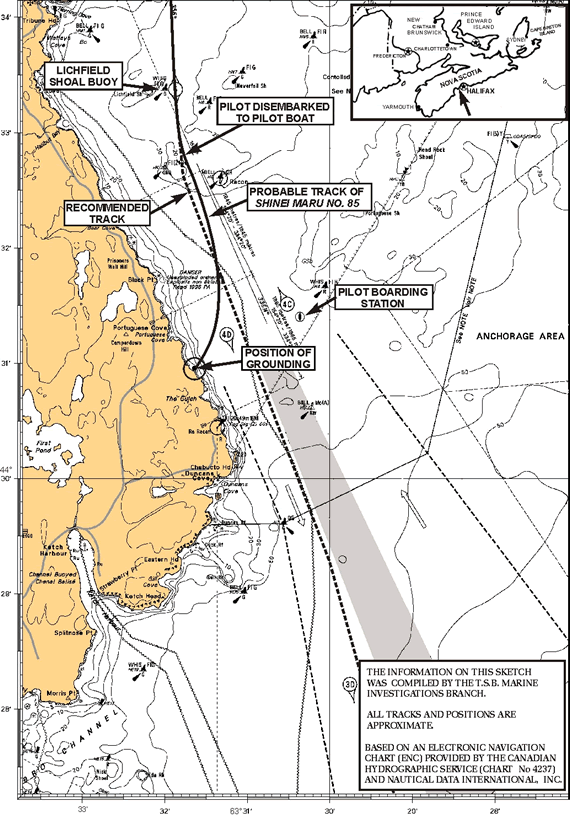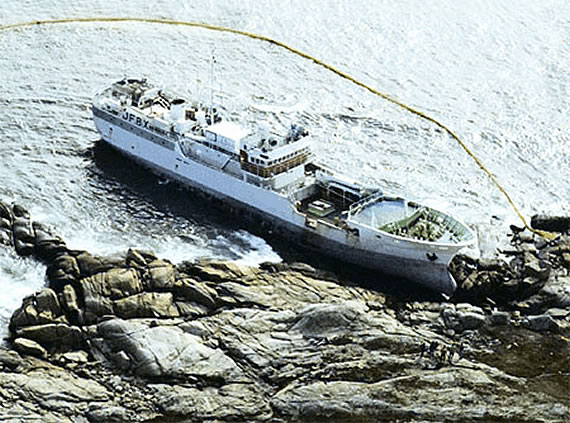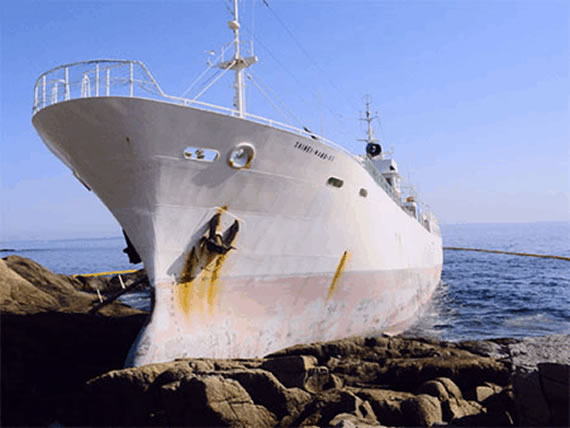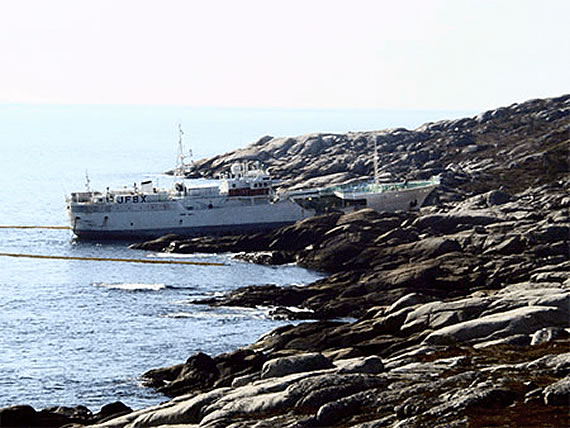Grounding
Large fishing vessel Shinei Maru No. 85
Approaches to Halifax Harbour
The Transportation Safety Board of Canada (TSB) investigated this occurrence for the purpose of advancing transportation safety. It is not the function of the Board to assign fault or determine civil or criminal liability. This report is not created for use in the context of legal, disciplinary or other proceedings. See Ownership and use of content. Masculine pronouns and position titles may be used to signify all genders to comply with the Canadian Transportation Accident Investigation and Safety Board Act (S.C. 1989, c. 3).
Summary
In the late evening of 03 May 2003, in clear conditions with moderate winds from the north-northwest, the Shinei Maru No. 85 was outbound from Halifax harbour when it ran aground near Portuguese Cove. Two fuel tanks were breached causing the loss of a considerable, but undetermined, amount of marine diesel oil. After the lightering of fuel oil, the vessel was towed off the rocks and escorted to Halifax for repairs. No one was injured.
Factual information
Particulars of the vessel
| Name | Shinei Maru No. 85 |
|---|---|
| Official number | 131497 |
| Port of registry | Yasuda, Kochi Prefecture |
| Flag | Japan |
| Type | Large Fishing Vessel (Longliner) |
| Gross tonsFootnote 1 | 379 |
| Length | 48.40 m |
| Draught | Forward: 2.6 m Aft: 4.8 m |
| Built | Steel, 1991, Kanasashi Co. Ltd., Shimuzu, Japan |
| Propulsion | One Niigata Diesel Engine, 736 kW, (1001 BHP) |
| Cargo | Frozen Tuna and Bait |
| Crew | 24 people |
| Owner | Sakata Suisan Ltd., Aki-gun, Kochi-ken, Japan |
Description of the vessel
The Shinei Maru No. 85 is a large fishing vessel of welded steel construction. Built as a longliner with tween deck fish processing facilities, it is currently engaged in the tuna fishing industry. The vessel carries frozen bait and has a refrigerated cargo hold enabling it to fish continuously for periods of up to three or four months before returning to port.
Introduction
On Japanese fishing vessels such as the Shinei Maru No. 85, the typical deck officer complement is four people: fishing master, captain, mate, and radio officer. The captain, although responsible for the safe navigation of the vessel, is outranked by the fishing master. In effect, the fishing master (who does not necessarily require any navigational background) tells the captain where to sail the vessel. The overall responsibility for the entire operation of the vessel and the harvesting of fish, rests with the fishing master.
In the case of the Shinei Maru No. 85, the fishing master was also the acting captain.
The Japanese officers on board the Shinei Maru No. 85 had limited understanding of English. Although the International Convention on Standards of Training, Certification and Watchkeeping for Seafarers (STCW) requires officers in charge of a navigational watch to have a working knowledge of English, the convention does not apply to fishing vessels.
History of the voyage
At approximately 2200Footnote 2 on 03 May 2003, the Halifax harbour pilot boarded the Shinei Maru No. 85 in preparation for the vessel's departure. There was no one on the bridge when the pilot arrived. A smell of alcohol was present, and the sounds of music and singing were coming from nearby on the same deck.
The pilot was met by the ship's agent (who was fluent in Japanese and English) and the fishing master/acting captain. The radio officer joined them on the bridge shortly after. Because the officers were not wearing uniforms, their ranks could not be determined by appearance. No introductions were made. The pilot explained port departure procedures to both officers with the ship's agent interpreting. Being familiar with the usual chain of command on Japanese longliners, the pilot assumed that the fishing master/acting captainFootnote 3 was the fishing master (with no navigational responsibilities) and that the radio officer, who appeared to him to be clear-eyed and alert, was the captain.
The ship's agent disembarked, and at 2214, the Shinei Maru No. 85 departed Pier 30 in Halifax en route to fishing grounds in international waters. The pilot was at the helm and the acting captain stood by the engine controls on the starboard side of the bridge. The radio officer stood by the very high frequency (VHF) radio also on the starboard side. The pilot changed over the steering control from manual steering to automatic pilot at Pleasant Shoal, about 1.2 miles from their point of departure.
A difference of five degrees was noticed between the gyro compass heading of the ship and the course selected on the autopilot. The degrees-calibrated dial for course selection on the autopilot was out of alignment by five degrees. Consequently, the pilot had to select a course of 155 degrees on the autopilot dial to steer a true course of 160 degrees Gyro (G) to a position off Sandwich Point. The vessel proceeded down the harbour, adjusting the courses as required, toward the pilot station. The mate, who was the only person on board with navigation experience, was not on the bridge because he was engaged in other departure-related activities on deck.
When the pilot called in his voyage status to Marine Communication and Traffic Services (MCTS) Halifax at check point 6, the vessel was at full ahead speed to ensure separation from a ship that was about to depart Halifax. There was no inbound traffic ahead of the Shinei Maru No. 85. The acting captain left the bridge and the pilot then set the autopilot to 170 degrees to come to a course of 175 degrees towards a position off Lichfield Shoal.
After the vessel had passed Lichfield Shoal, buoy (H7), the pilot set the autopilot to 155 degrees (160° G) and made the officer, who was later identified as the radio officer, aware of this selected course for safe transit in accordance with the traffic separation scheme. At the pilot's request, the radio officer reduced the engine control to dead slow ahead to allow the pilot boat to come alongside. Some time between the vessel's departure from berth and the time the pilot disembarked, the pilot had the radio officer, who he believed was the captain, sign the pilot's source form, which verifies that the pilotage has been carried out.
At about 2245, some 1.5 miles before the pilot boarding station (inside the compulsory pilotage area), the pilot transferred to the pilot boat. Following the pilot's departure, the acting captain was in his cabin and only the radio officer was on the bridge. A few minutes later, the mate arrived in the wheelhouse for the first time during the voyage, and he called the acting captain to the bridge to discuss arrangements for seamen's watches. Around this time, the engine control was set to full ahead speed. While the three officers were on the bridge, no one was monitoring the vessel's progress.
At approximately 2300, the Shinei Maru No. 85 was estimated to have been at or near full ahead speed when it ran hard aground near Portuguese Cove. None of the personnel on the bridge were aware that the vessel was in danger of running aground. The vessel was holed in two fuel tanks allowing oil to leak from the vessel. An oil spill containment boom was placed around the vessel soon after going aground, but a considerable and undetermined amount of oil pollution had been released into the environment. No one was injured.
See:
- Appendix A - Sketch of occurrence area
- Appendix B - Photographs of grounded vessel
Events following the grounding
Immediately after the grounding, the acting captain attempted to reverse the vessel off the rocks, but the Shinei Maru No. 85 was stuck fast.
The pilot was returning to Halifax in the pilot boat when he overheard a radio communication between the MCTS Halifax and another vessel, reporting that the Shinei Maru No. 85 had run aground. The pilot boat then returned the pilot to the grounded vessel so that he could offer assistance. He was accompanied by another pilot who had just completed a pilotage assignment. When both pilots boarded the grounded vessel at 2330, the acting captain reportedly displayed aggressive behaviour towards the pilot who had navigated the Shinei Maru No. 85. One of the pilots advised MCTS Halifax to call the RCMP as he suspected that the acting captain had been drinking alcohol. An RCMP officer arrived on the scene some time later, but a blood-alcohol test was not administered.
During the time that both pilots were on the bridge, one of them noticed that the radar screen had been switched to night-time presentation and the steering had been set to manual. The gyrocompass heading was 218 degrees.
On the following day, 04 May, attempts by a local tugboat to tow the Shinei Maru No. 85 off the rocks at high tide failed. On the afternoon of 05 May, after the lightering of fuel oil, the vessel was successfully towed off the shore at high tide by two tugboats. The vessel was subsequently escorted to Halifax harbour for damage survey and repair.
Bridge operating practices and procedures
There was no ship's personnel acting as helmsman nor was a dedicated lookout posted from the time the vessel departed Halifax to the time of the grounding. During the period of time between the pilot disembarking and the mate's initial visit to the wheelhouse, there was no watchkeeping officer on the bridge. The vessel's progress was not monitored by radar nor by visual means, and positions were not plotted on a chart.
Weather information
In late evening darkness, the skies were clear with good visibility and winds were from the north-northwest at 15 to 20 knots.
Damage to the vessel
The hull was breached in three places, and the bulbous bow was damaged. A fracture in the bottom plating on the forward end of No. 8 tank at midships measured 175 mm long by 10 mm wide. Approximately 2.4 m aft of this area in way of No. 8 tank was a fracture 51 mm long by 1 to 2 mm wide. On the port side in way of No. 6 tank a fracture 113 mm long by 1 to 2 mm wide was found. The bulbous bow was stove in on the port side - the indentation was 2 m long by 700 mm wide by 450 mm deep.
Officers' certification and experience
Fishing Master/Acting Captain
The fishing master/acting captain held a valid Fourth Grade Maritime Officer's (Engineering) Certificate, issued in Japan and endorsed pursuant to the International Convention on Standards of Training, Certification and Watchkeeping for Seafarers 1978, as amended in 1995. He held no navigation certificates, nor had he received any formal navigational training apart from basic supplementary courses at fisheries school some 30 years ago when he received his engineer's certificate. He did not have a working knowledge of English.
During three decades of experience on Japanese vessels, he served about 24 years as an engineer until 1997, when he became a fishing master. In August 2002, he assumed the additional role of captain. His previous experiences commanding a vessel while entering or leaving port were during a previous voyage to Halifax in February 2003 and on a trip to Cork, Ireland.
Chief Mate
The mate held a Fifth Grade Maritime Officer (Navigation) certificate issued in Japan. He had been granted an exemption which permitted him to sail on vessels of 200 in gross tonnage and above. (The Shinei Maru No. 85 is 379 in gross tonnage.) His certificate was also STCW 95 endorsed. He did not have a working knowledge of English.
He had eight years experience as an officer on Japanese tuna boats and served on the Shinei Maru No. 85 for 17 months.
Radio Officer
The radio officer had 15 years experience at sea, the past three and a half years of which were on the Shinei Maru No. 85. He had no other certification or experience in any capacity other than that of radio officer.
Halifax Harbour Pilot
The pilot held a Master Mariner's certificate issued in 1997. He began work in Halifax with the Atlantic Pilotage Authority (APA) in October 2000. He holds a Class A pilotage license issued by the APA, a regulatory body empowered by the Pilotage Act.
Navigation equipment
The radar, gyro compass, autopilot, VHF radio, GPS navigator, echo sounder, and a video plotter/recorder, were all operational during the voyage from Halifax.
The type of video plotter on board is used more as a fishing aid rather than a navigational tool. It illustrates the track the vessel has travelled in order to locate the fishing gear and to determine where longlines are set, but the unit cannot display navigation charts.
The vessel's officers and the pilot were aware that the degrees-calibrated dial for course selection on the autopilot was offset by five degrees. To steer a chosen course by autopilot, it had to be set five degrees less than the desired gyro compass heading. The autopilot was reported to have worked well.
The appropriate charts for transiting Halifax harbour were on board, but they were not used.
Marine Communications and Traffic Services Halifax
Marine Communications and Traffic Services Halifax monitors vessel traffic by radar and by VHF radio. All voice traffic on VHF radio and telephone is recorded. Vessel movements monitored by radar are usually recorded on videotape, but due to technology upgrades taking place during the time of the occurrence, this was not possible. Upgrades included changing over to digital radar, and operators had expressed concern that, at the time of the occurrence, the radar would "lose" some targets as the actual vessels approached Chebucto Head. When this happened, the operator had to reacquire the target images. The operator "lost" the Shinei Maru No. 85 about three times before grounding.
Alcohol
The acting captain had consumed alcohol before the vessel departed Halifax. After the grounding, the acting captain reportedly had watery eyes, and his breath smelled of alcohol. A blood-alcohol test was not administered.
Port State Control
Port State Control (PSC) is a ship inspection program established world wide to ensure that foreign vessels entering sovereign waters comply with various international maritime conventions adopted by flag states. An inspection assesses the general seaworthiness of the vessel, the condition of the vessel's equipment, and the validity of the documentation for the vessel and its crew. Currently, fishing vessels are not covered under either the Tokyo or Paris Memorandum of Understanding on PSC.
Analysis
Hand-over briefings
On the Shinei Maru No. 85, an initial hand-over briefing between the pilot and the acting captain would have been difficult because of the language barrier. However, the pilot's instructions to depart from the wharf were relayed to both Japanese officers using the ship's agent as interpreter. At that time, the role of each person on the bridge ought to have been clearly established, but was not.
Given that it is the ultimate responsibility of the master to ensure the safe navigation of the vessel at all times, the acting captain ought to have made himself known to the pilot to receive a hand-over briefing and to discuss the pilot's intended passage plan. Those involved made assumptions, and formal hand-over briefings were not carried out.
Communication difficulties
While the acting captain possessed a certificate that was STCW endorsed, that certificate was inappropriate to operate a vessel of this size and type. The Japanese officers did not have a working knowledge of English. Because of poor communication and the lack of introductions, the pilot assumed that the fishing master/acting captain was acting solely as the fishing master, and that the radio officer was the captain. The inability to effectively communicate led the pilot to hand over the con of the vessel to an unqualified person.
Bridge operating practices and procedures
To ensure safe passage in confined waters, a vessel's progress must be closely monitored. Without full knowledge of a vessel's position in relation to the surroundings, the navigational officer's situational awareness is lost.
The pilot disembarked the vessel within the limits defined by the pilotage regulations. The exact disembarkation point is left to a pilot's discretion. The Atlantic Pilotage Authority Regulations permit a pilot to embark or disembark a vessel inside the compulsory pilotage waters during heavy weather.Footnote 4 In this instance, the winds were from the northwest at 15 to 20 knots and the pilot elected to disembark about 1.5 miles inside of the pilot boarding station (see Appendix A).
The mate, who was the only person on board with formal navigational training, was not on the bridge because he was engaged in other departure-related activities on deck. Further, the progress of the vessel in pilotage waters and the outer reaches of the harbour was not effectively monitored by ship's personnel.
Following the pilot's departure, the acting captain was in his cabin, leaving only the radio officer on the bridge. The mate arrived on the bridge several minutes later and called the captain to the bridge to discuss the seamen's watches. Although there were three officers on the bridge, no dedicated lookout or helmsman was posted, the radar was not monitored, and the progress of the vessel was neither checked against a chart nor were visual references made. No ship-positions were entered in the log book or plotted on the chart.
By not having appropriate bridge personnel at their stations during the safety critical phase after the pilot had disembarked, no one was actively engaged in navigating or steering the vessel. Consequently, the officers on the bridge were unaware of the impending danger that resulted in the vessel running aground.
Navigation equipment
The type of video plotter on board was used as a fishing aid rather than as a navigational aid. Nevertheless, the vessel's track inbound to Halifax was displayed on the video plotter, and the outbound course to grounding was also visible. The outbound plot line followed the recommended route up until a point just after Lichfield Shoal (when the pilot disembarked). The straight-line plot of the vessel's track then changes direction from Lichfield Shoal to the point of grounding (see Photo 3). However, the probable trackFootnote 5 of the vessel is as shown in Appendix A.
The gyro compass and the autopilot were functioning satisfactorily, and those involved with navigating the vessel were aware of, and applied, the five-degree autopilot course selection calibration error. There was no information to conclude that following the departure of the pilot, the gyro compass and/or autopilot malfunctioned, that the heading on the auto pilot had been changed, or that the autopilot had been switched to manual. However, the possibility of the autopilot malfunction, autopilot adjustment, or the autopilot being disengaged cannot be discounted.
Owing to a wide range of variables, it is not possible to conclude which factor(s) contributed to the change in heading. However, if the bridge personnel had closely monitored the radar display and other navigation equipment, they would have known that the vessel was either falling off or altering course to starboard. It follows that the navigation personnel were inattentive and were not effectively monitoring the vessel's progress.
Alcohol consumption
Although it cannot be determined how much alcohol the acting captain consumed before departure, his appearance and behaviour were consistent with someone who had consumed a sizable quantity of alcohol. The degree to which this affected his performance and attitude cannot be determined as blood-alcohol tests were not administered.
Marine Communications and Traffic Services Halifax
The operator on watch at MCTS Halifax did not notice the Shinei Maru No. 85 veering outside the recommended outbound track, possibly because the radar had "dropped" the target. This radar glitch happened quite frequently due to ongoing upgrades to the system. However, by the time the pilot disembarks a vessel, it is normally on a safe course towards open seas and requires less attention by operators than traffic in more risk-prone areas.
Since the occurrence, MCTS operators have reported improved performance of the radar system.
Port State Control
Port records indicate that in 2001 there were 109 similar vessels (Japanese longliners) that called at the port of Halifax. In 2002, there were 105, and between January and October in 2003, there were 52. In St. John's, Newfoundland and Labrador, there were 30 visits in 2001 and 41 visits in 2002.
There is no Port State Control inspection requirement on these types of foreign vessels. The need for extending PSC inspections to fishing vessels has been recognized by the International Maritime Organization. The PSC requirement has been addressed in Article 8 of the International Convention on Standards of Training, Certification and Watchkeeping (STCW) for Fishing Vessel Personnel, 1995, (STCW-F/95), which has not yet come into force. The convention requires ratification by 15 member countries and to date only 4 have ratified it. The PSC inspections will provide the opportunity to identify shortcomings, not only with respect to the condition of the vessel but also regarding the adequacy of crew certification.
Findings
Findings as to causes and contributing factors
- The Shinei Maru No. 85 deviated from its course at the outer reaches of Halifax harbour and grounded for undetermined reasons.
- No one was monitoring the progress of the vessel after the pilot disembarked, and the deviation in course and its cause went undetected.
- Safe bridge operating practices and procedures, including basic watchkeeping, were not followed.
- The officers' inadequate English skills precluded effective communication essential for bridge resource management during pilotage.
- The pilot disembarked the vessel some 1.5 miles inside the pilot boarding station within the compulsory pilotage area.
Findings as to risk
- The acting captain was not properly certificated to have conduct of the Shinei Maru No. 85. The vessel operated at sea for extended periods of time with only one person qualified in navigation.
- The acting captain had consumed alcohol before the vessel's departure from Halifax.
- There is no requirement for Port State Control Inspections on fishing vessels, which allows deficiencies in the operation of these vessels to go undetected.
Safety action
Action taken
In October 2003, the Transportation Safety Board (TSB) issued two Marine Safety Information letters, 10/03 and 11/03, to Transport Canada with a copy to the Central Marine Accident Inquiry Agency in Japan advising them of TSB observations regarding the adequacy of certification/vessel crewing and inadequate bridge operating procedures and practices.
In response to these concerns, Transport Canada made reference to international initiatives underway that, when fully implemented, have the potential to further safety. Furthermore, Transport Canada will prepare a paper for the IMO STCW Committee identifying the need for flag states that have fishing vessels operating in international waters to ratify the STCW-F/95 convention, or to have their crews certified in accordance with the convention's basic principles.
Japan conducted an inquiry into this occurrence and recommended that relevant rules and regulations respecting the qualifications of shipboard personnel be respected by both the vessel operators and staff to help ensure safe operation.
Following this occurrence, the Atlantic Pilotage Authority (APA) took measures to formalize best practices in pilotage by more clearly defining the roles of master and pilot in circumstances where the pilot embarks or disembarks at a position other than the pilot boarding station. This would allow a pilot, in bad weather or ice conditions, to board or leave a vessel at a place other than a pilot boarding station. To ensure safety is not compromised, the following procedures are to be followed:
- The master agrees to embark/disembark a pilot at a location within the compulsory pilotage area.
- The pilot maintains contact with the master and visually monitors the vessel's progress while the vessel is within the compulsory pilotage waters.
These proposed amendments appear in the form of a completely new procedure described in section 9.1 of the APA Regulations that went into the Canada Gazette Part 1 in April 2004. The amendments are part of a larger amendment package. As there were objections by some stakeholders, the Minister has appointed an investigator to determine the validity of the objections. The review began the week of 08 November 2004 and will be considered by the Minister in March/April 2005.
This report concludes the Transportation Safety Board's investigation into this occurrence. Consequently, the Board authorized the release of this report on .
